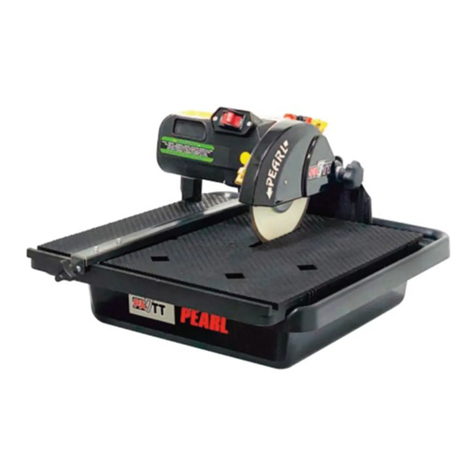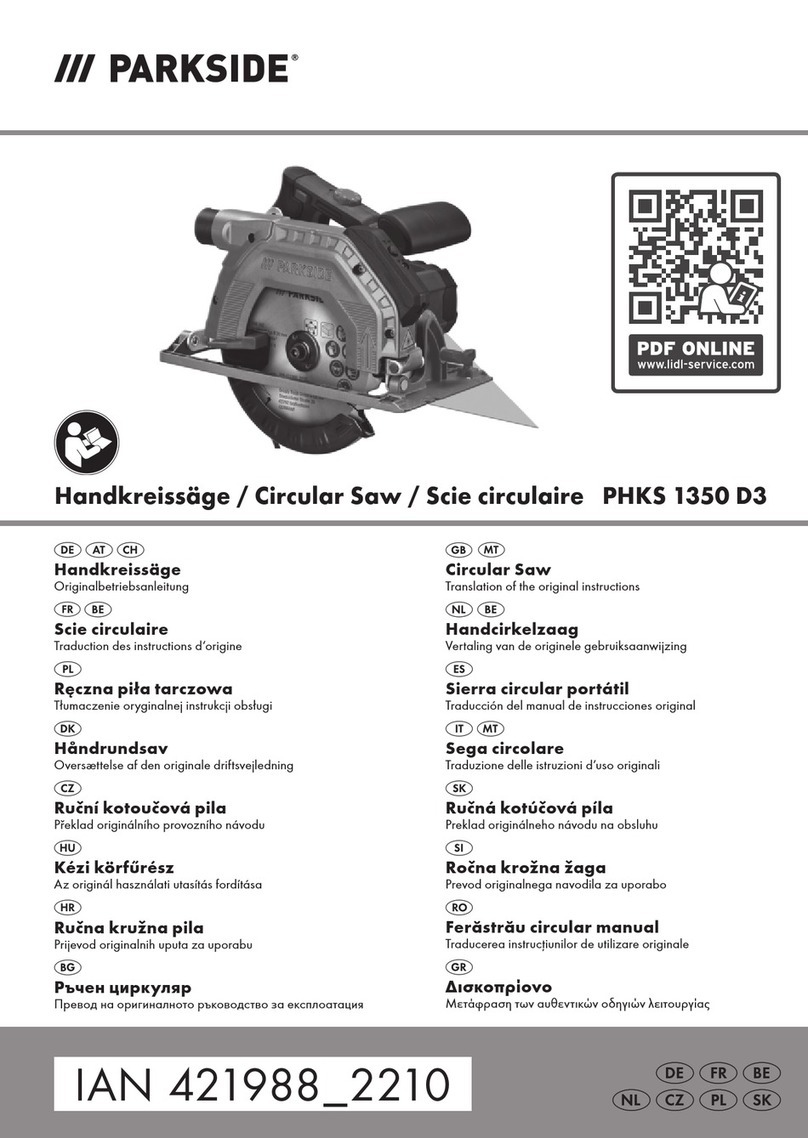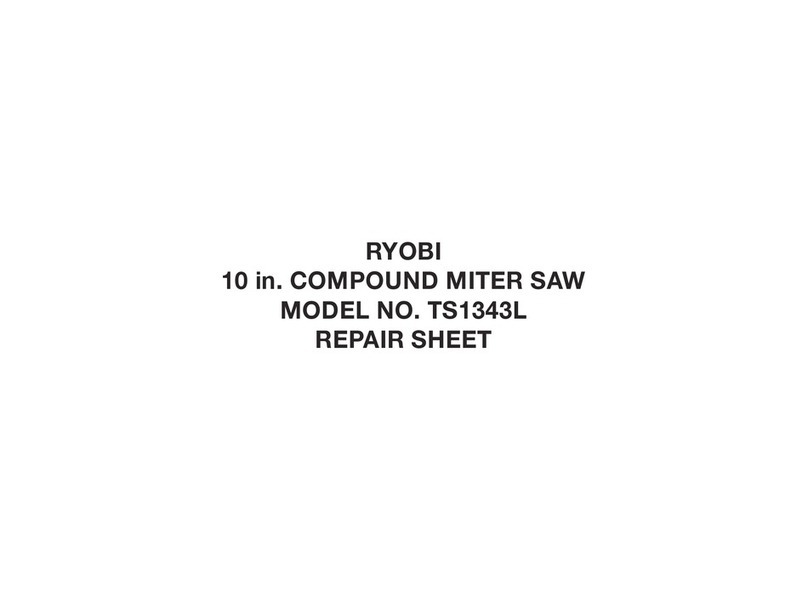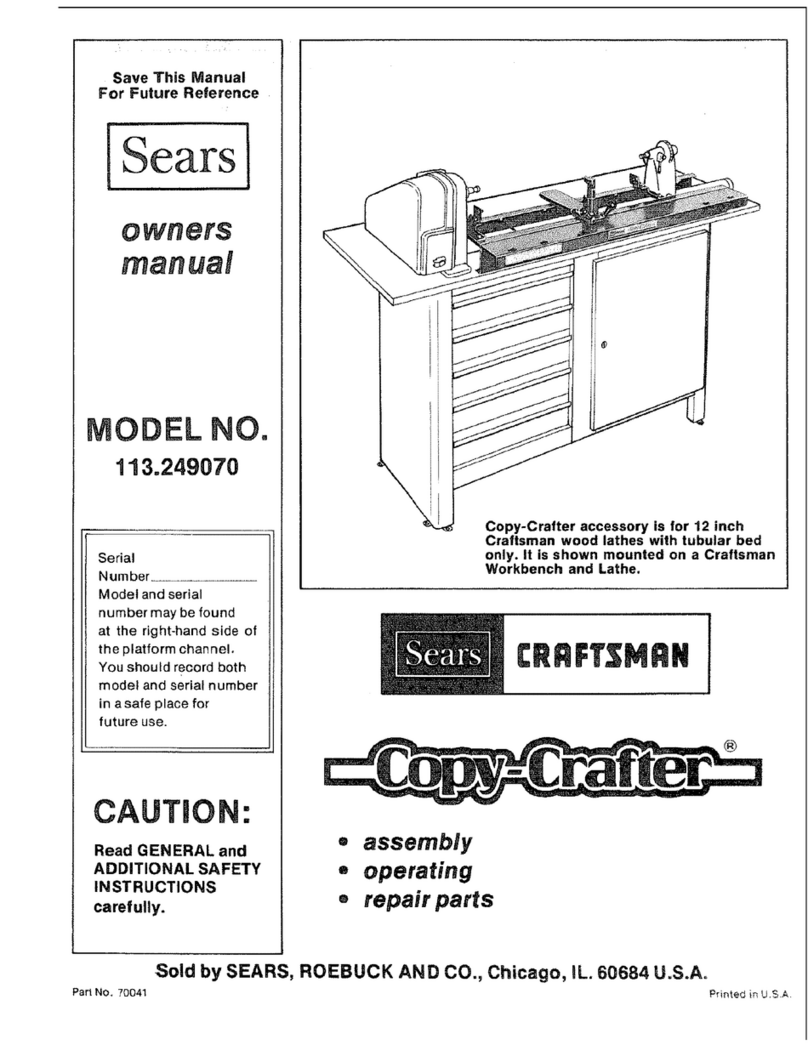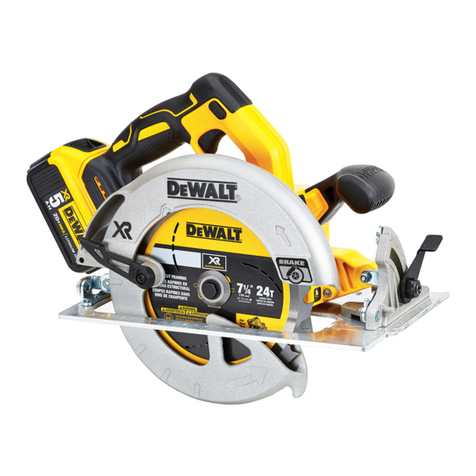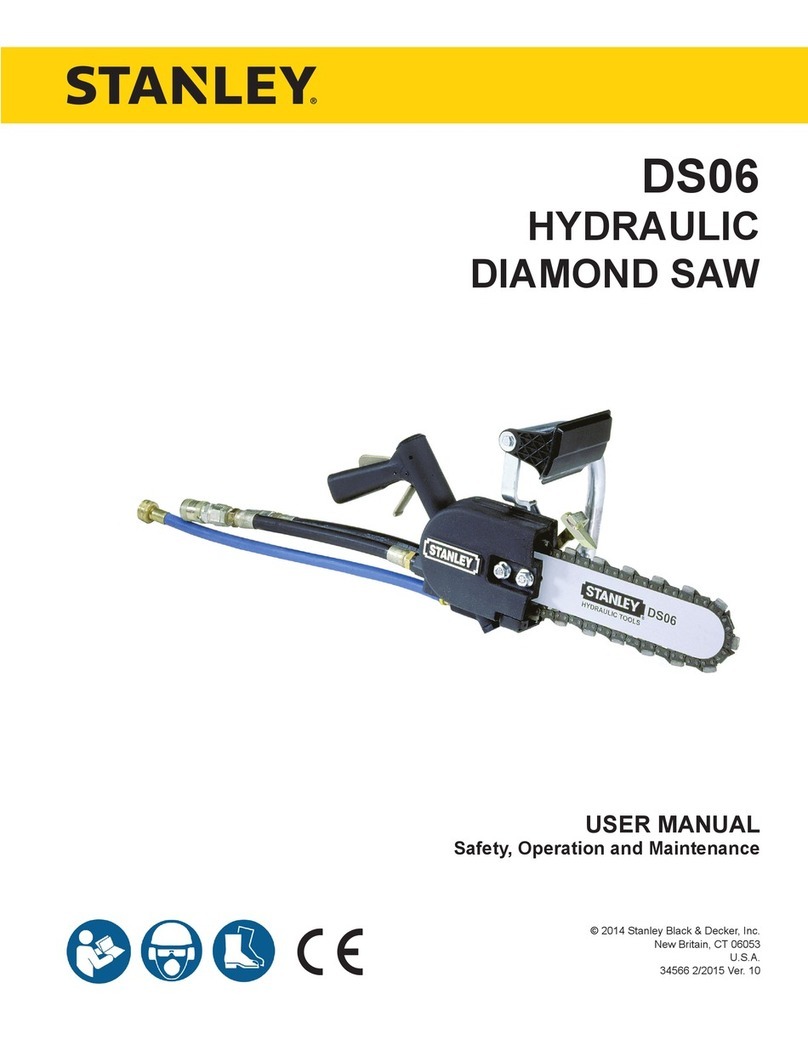Pearl VX5WV Owner's manual

serial number -
Caution! Read Safety and General Instructions carefully before using saw for the first time.
You should record the Serial Number of your Tile Saw on this
Owner’s/Operator’s Manual and on the Warranty Card.
The Warranty Card must be sent back with all the required
pertinent information for the warranty to take effect.
REV. 1
Pearl Abrasive Co. portable SAW
MODEL VX5WV™ PORTABLE
HANDHELD TILE SAW
OWNER’S/OPERATOR’S MANUAL
Blade sold
separately

TABLE OF CONTENTS
I. GENERAL SAFETY RULES FOR ALL POWER TOOLS. . . . . . . . . . . . . . . . . . . . . . . . . . . . . . . . 3
II. SYMBOLS . . . . . . . . . . . . . . . . . . . . . . . . . . . . . . . . . . . . . . . . . . . . . . . . . . . . . . . . . . . . . . . . . . . 4
III. FEATURES . . . . . . . . . . . . . . . . . . . . . . . . . . . . . . . . . . . . . . . . . . . . . . . . . . . . . . . . . . . . . . . . . . . 5
IV. SPECIFICATIONS . . . . . . . . . . . . . . . . . . . . . . . . . . . . . . . . . . . . . . . . . . . . . . . . . . . . . . . . . . . . . 5
V. UNPACKING . . . . . . . . . . . . . . . . . . . . . . . . . . . . . . . . . . . . . . . . . . . . . . . . . . . . . . . . . . . . . . . . 6
VI. ASSEMBLE AND SET-UP. . . . . . . . . . . . . . . . . . . . . . . . . . . . . . . . . . . . . . . . . . . . . . . . . . . . . . . . 6
VII. SET-UP FOR WET AND DRY CUTTING . . . . . . . . . . . . . . . . . . . . . . . . . . . . . . . . . . . . . . . . . . 7
VIII. OPERATING THE SAW. . . . . . . . . . . . . . . . . . . . . . . . . . . . . . . . . . . . . . . . . . . . . . . . . . . . . . . . 7
IX. SAFE OPERATING PRACTICES. . . . . . . . . . . . . . . . . . . . . . . . . . . . . . . . . . . . . . . . . . . . . . . . . . 9
X. CARE AND MAINTENANCE . . . . . . . . . . . . . . . . . . . . . . . . . . . . . . . . . . . . . . . . . . . . . . . . . . 12
XI. PROPER BLADE USE . . . . . . . . . . . . . . . . . . . . . . . . . . . . . . . . . . . . . . . . . . . . . . . . . . . . . . . . . 13
XII. AVAILABLE ACCESSORIES . . . . . . . . . . . . . . . . . . . . . . . . . . . . . . . . . . . . . . . . . . . . . . . . . . . . . 14
XIII. NOTES. . . . . . . . . . . . . . . . . . . . . . . . . . . . . . . . . . . . . . . . . . . . . . . . . . . . . . . . . . . . . . . . . . . . . 15
PAGE

–3–
i. GENERAL SAFETY RULES FOR ALL POWER TOOLS
1. Know your power tool - read owner’s/operator’s manual carefully. Learn its applications and limitations as
well as the specific potential hazards unique to this tool.
2. Keep guards in place - and in working order.
3. Ground all tools - if tools are equipped with three prong plug, it should be plugged into a three-hole electrical
receptacle. If an adapter is used to accommodate a two-prong receptacle, the adapter lug must be attached
to a known ground. Never remove the third prong.
4. Remove wrenches - Form a habit of checking to see that adjusting wrenches are removed from tool before
turning it “on”.
5. Keep work area clean. Cluttered areas and benches invite accidents.
6. Do not use in dangerous environment. Do not use power tools in damp or wet locations, or expose them to
rain. Keep work area well lighted. Do not use tool in the presence of flammable liquids or gasses.
7. Keep children and visitors away. All children and visitors should be kept at a safe distance from work area.
8. Make workshop childproof with padlocks, master switches or by removing starter keys.
9. Do not force tool. It will do the job better and be safer at the rate for which it was designed.
10. Use right tool. Do not force tool or attachment to do a job for which it was not designed.
11. Wear proper apparel. Do not wear loose clothing, gloves, neckties, rings, bracelets or other jewelry that may
get caught in moving parts. Non-slip footwear is recommended. Wear protective hair covering to contain
long hair.
12. Always use safety glasses. Wear safety glasses (must comply with ANSI Z87.1) at all times. Everyday
eyeglasses only have impact resistant lenses; they are not safety glasses. Use face or dust mask if cutting
operation is dusty, and ear protectors (plugs or muffs) during extended periods of operation.
13. Do not overreach. Keep proper footing and balance at all times.
14. Maintain tools in top condition. Keep tools sharp and clean for best and safest performance. Follow
instructions for lubricating and changing accessories. Inspect tool cords periodically and if damaged, have
repaired by authorized service facility.
15. Disconnect tools. When not in use, before servicing, and when changing accessories, such as blades, bits,
cutters.
16. Avoid accidental starting. Make sure switch is in “off” position before plugging in power cord.
17. Use recommended accessories only. Consult the owner’s manual for recommended accessories. The use
of improper accessories may cause risk of injury to persons.
18. Never stand on tool. Serious injury could occur if the tool is tipped or if the cutting tool is accidentally
contacted.
19. Check Damaged Parts. Before further use of the tool, a guard or other part that is damaged should be
carefully checked to ensure that it will operate properly and perform it’s intended function. Check for
alignment of moving parts, binding of moving parts, breakage of parts, mounting, and any other conditions
that may affect it’s operation. A guard or part that is damaged should be properly repaired or replaced.
20. Never leave tool running unattended. Turn power “off”. Do not leave tool until it comes to a complete stop.
Read all instructions.
As with all machinery there are certain hazards involved with
operation and use of the machine. The following basic safety precautions should be followed at all times to
reduce the risk of fire, electric shock and serious personal injury to you or others.
Keep these important
operating instructions with this product.
WARNING!

–4–
KEEP GUARD IN PLACE
DIAMOND BLADE
BLADE CUTTING DEPTH
ELECTRIC SWITCH OFF
ELECTRIC SWITCH ON
ELECTRICAL HAZARD
REMOVE TOOLS
PAY EXTREME
ATTENTION
REPAIRS TO BE DONE
MACHINE HAZARD
FLAMMABLE
READ INSTRUCTIONS
CAREFULLY
WARNING
FRAGILE
KEEP DRY
DO NOT STEP ON
WEAR HEARING
PROTECTION
WEAR EYE PROTECTION
WEAR BREATHING
PROTECTION
WEAR HARD HAT
WEAR PROTECTIVE
CLOTHING
WEAR SAFETY SHOES
WELL VENTILATED
NO NON-WORKING
PERSONNEL
21. Extension cords. Make sure your extension cord is in good condition. When using an extension cord, be
sure to use one heavy enough to carry the current your product will draw. An undersized cord will cause a
drop in line voltage resulting in loss of power and overheating. Extension cord tables
(refer to page 21
) show
the correct size to use depending on cord length and nameplate ampere rating. If in doubt, use the next
heavier gage. The smaller the gage numbers the heavier the cord.
22. Do not abuse cord. Never carry tool by cord or pull it to disconnect from receptacle, Keep cord from heat,
oil, and sharp edges.
23. Guard against electric shock. Prevent body contact with grounded surfaces. For example, pipes, radiators,
ranges and refrigerator enclosures.
24. Outdoor use extension cords. When tool is used outdoors, use only extension cords intended for use
outdoors and so marked.
25. Stay alert. Watch what you are doing. Use common sense. Do not operate tool when you are tired.
26. Drugs, alcohol, medication. Do not operate tool while under the influence of drugs, alcohol or any
medication.
27. Store idle tool. When not in use, tool should be stored in a dry and locked place, out of reach of children.
ii. SYMBOLS
CALIFORNIA PROPOSITION 65: Sawing and drilling generates dust. Excessive airborne
particles may cause irritation to eyes, skin and respiratory tract. To avoid breathing impairment always employ
dust controls and protection suitable to the material being saw or drilled in accordance with OSHA (29 CFR Part
1910.1). Diamond blades improperly used are dangerous. Comply with ANSI Safety Code B7.1 and OSHA covering
speed, safety guards, flanges, mounting procedures, general operating rules, handling, storage and general
machine condition.
WARNING!

–5–
iii. FEATURES
VX5WV PORTABLE TILE SAW
MOTOR MAX. BLADE
CAPACITY
CUTTING
LENGTH
CUTTING
DEPTH WEIGHT
iv. SPECIFICATIONS
5" Blade with
20mm arbor size
Length: Unlimited
Diagonal: Unlimited
Depth of Cut:
1-11/16"
Depth of Cut (miter):
1-3/8"
8.4 lbs.
11 AMPS
115 v, 60 Hz,
12,000 rpm
• Powerful 11 amps motor
• Rip guide
• Miter cut
• Vacuum port and blade
guard cover for dust control
• Trigger lock
• Over 4cm depth of cut with
5" blade
• Side handle for additional
support
• Water hose system with
control valve
• GFCI Included

–6–
vi. ASSEMBLY and SET-UP
1. Open the carton box.
2. Remove the rip guide and dust guard cover.
3. Remove the carton partition and remove the
remaining components. Recycle packaging but
retain the manual.
4. Remove the blade shaft bolt and outer flange.
Install the provided blade and reinstall the
outer flange and blade shaft bolt.
5. Using the provided closed box wrench and I-
socket wrench, tighten and blade shaft nut.
6. If cutting wet, install the blade guard hoses
onto the blade guard. Install the garden hose
assembly onto blade guard hose assembly
valve if necessary.
7. Install side handle onto blade guard.
1. Using the provided close box wrench and t-
socket wrench (turning clockwise), loosen the
blade shaft nut. Remove the outer flange.
2. Install the blade and reinstall the outer flange
and blade shaft bolt (see fig. 2).
3. Screw in the side handle if removed (see fig. 4).
Figure 1
v. UNPACKING
Open the carton box cover by lifting the top portion.
Locate the accessory box and check its content for the
following items before discarding any packaging:
1 Saw
2Side handle
3T-Socket wrench
4Closed box wrench
5Rip guide
6Owner's manual
7Dust guard cover
8Garden hose assembly
9Blade guard hose assembly (partially
installed on power cable)
10 Manual
11 Blade (sold separately)
BLADE INSTALLATION
WARNING: Disconnect the power plug before
installing the blade onto the blade shaft.
Figure 2

–7–
vii. SETUP FOR WET OR DRY CUTTING
1. To cut wet remove side handle to remove the dust guard
(see fig 4).
2. Insert the hose (2) to the the ports on the guard. Re-
insert the r-clip into each hose (see fig. 3).
3. Attach each hose to the y-fitting below the handle. Pull
hoses from both ends to check if secure (see fig. 4).
WET CUTTING
DRY CUTTING
Figure 3
Figure 4
1. If cutting dry, locate r-clips inserted in the hose portion protruding in
the blade guard. Pull out each hose’s respective r-clip. With the
blade guard water hoses removed, insert r-clips back into the hose
for storage. Store hoses for use later (see fig. 4).
2. Pull out hoses going to y-adapter by pressing the red
rings inwards and then pulling the hose out
the opposite direction.
3. Install the dust guard.
4. Screw the side handle onto
the blade guard (see fig.
4). Remove the vacuum
port cap and attach a
vacuum hose (see fig. 2
and 4).
WARNING: Water pressure going to hose
assembly should not exceed 80 psi.
WARNING: Disconnect the power plug before
installing the blade onto the blade shaft.
1. ANSI Z87.1 Eye protection
WARNING: Everyday eyeglasses are NOT safety glasses
2. ANSI S12.6 (S3.19) Hearing protection
WARNING: Under some conditions and duration of use,
noise from this product may contribute to hearing lose
3. NIOSH/OSHA/MSHA Respiratory protection
WARNING: Some dust created by power sanding,
sawing, grinding, drilling, and other construction
activities contains chemicals known to the State of
California to cause cancer, birth defects or other
reproductive harm. Some examples of these chemicals
are:
• lead from lead-based paints,
• crystalline silica from bricks and cement and
other masonry products, and
• arsenic ahd chromium from chemically-treated
lumber.
Your risk from these exposures varies, depending on
how often you do this type of work. To reduce your
exposure to these chemicals: work in a well
ventilated area, and work with approved safety
equipment, such as those dust masks that are
designed to filter out microscopic particles.
viii. OPERATING THE SAW
Figure 4

WARNING: Disconnect the power plug before
installing or removing the blade or
accessories, and before adjusting or making
repairs to the power tool.
CAUTION: Use clamps or other mechanical
means to support and hold the workpiece to a
stable platform placed on a reliable flat
surface. DO NOT hold the workpiece by hand
or against the body.
CAUTION: Never cut overhead. Cut only on
horizontal surfaces when using water.
1. Loosen depth adjustment screw (see fig. 6).
2. Move the skid to the desired position.
3. Retighten the depth adjustment screw.
DEPTH ADJUSTMENT
1. Loosen angle adjustment screw (see fig. 7).
2. Move the skid to the desired position.
3. Retighten the angle adjustment screw.
ANGLE ADJUSTMENT
1. Loosen the two wing screws.
2. Slide the rip guide into the skid (see fig. 8).
3. Using the blade path pointer as reference,
slide the rip guide into position.
4. Retighten the two wings screws.
USING THE RIP GUIDE
1. Using a marker or grease pencil, mark the
area to be cut.
2. Place the skid of the saw on the workpiece
such that the blade does not touch the
workpiece.
3. Align the blade path pointer with the
outline of the marked area.
4. Turn the tool on and wait for the blade to
reach its maximum rpm.
5. Move the tool slowly forward while
keeping the blade aligned with the cut line.
STRAIGHT/ANGLED CUTS
Figure 6
Figure 7
Figure 8

–9–
ix. SAFE OPERATING PRACTICES
1. Use safety equipment - wear safety approved
hearing, eye, head and respirator protection.
2. Read and understand the symbol definitions
contained in this manual.
3. Read and understand all warnings and
instructions on the machine.
4. Read all safety materials and instructions that
accompany any blade or accessory used with
this machine.
5. Establish a training program for all operations
of this machine.
6. Always provide a copy of this manual to the
equipment user. If you need extra copies
call our Customer Service Department at
1-800-969-5561.
7. Always select a diamond blade according to
the manufacturers recommendation suitable
for the material to be cut. Never use a blade
having a maximum operating speed lower than
the “No load R.P.M.” marked on the tool
nameplate. Do not operate any saw without
safety guards in place or with a blade diameter
larger than the maximum saw blade capacity.
8. Before mounting a blade on the saw clean and
inspect the arbor shaft, blade flanges and the
diamond blade for uneven wear or damage. If
it appears to be damaged,
Do not operate the
tool.
Have it serviced by a qualified service
technician.
9. Before each use of the saw, inspect the
diamond blade for hairline fatigue cracks. If
such a crack or flaw is evident, discard the
blade.
Using a damaged blade may cause
injury to the operator or others.
10. Be sure that the blade arbor hole matches the
blade adapter flange supplied with the saw.
Use only blade adapter flanges that came on
your saw. Never use damaged or worn blade
adapter flanges.
11.
Installing the blade,
install the blade with the
arrow pointing the same direction as the
rotation of the arbor shaft or the arrow on the
blade guard. Be sure to tighten the blade shaft
arbor nut with the wrench provided.
Be careful not to over tighten.
12. Sometimes the material being cut is not
abrasive enough to expose new diamonds on
the blade. If the blade is not sharpened, it will
rub against the surface resulting in heat build
up in the core. To prevent this, it is necessary
to dress the blade. To dress the blade simply
cut something that is very abrasive such as a
piece of cement block. Indications that the
blade needs dressing includes:
• The diamond in the matrix appear shiny
because they are worn flat.
• The blade stops cutting or noticeably
slows down.
Blade dressing stones are available from your local Pearl
Warehouse.
•Do not attempt to cut pieces too small to
safely hold down.
•Never use the side of the blade to cut or
grind with, only cut in a straight line.
•Keep all parts of your body away from the
blade and all other moving parts.
•Never touch or try to stop a moving blade
with your hand.
•Do not use a wet cutting blade for dry
cutting. Select the proper dry cutting
blade for your application.
•Never make long continuous cuts with dry
The dust generated by cutting
of tile, marble, stone, bricks etc. can be injurious
to your health. Always operate machinery in well
ventilated areas and provide proper dust removal.
Always wear a dust mask approved for respiratory
protection against these types of dusts and mists.
For your own safety and the
safety of others do not attempt to operate this saw
until you have read and understand the general
safety rules for all power tools and the following
additional safety precaution unique to this saw.
WARNING!
WARNING!
Not dressing the blade
frequently or setting the blade too high will cause
it to grab the tile possibly causing injury to the
operator and the saw. Setting the blade depth too
low will cause it to cut into the main table that
may result in injury.
WARNING!

– 10 –
cutting blades. To avoid heat build up,
allow the blade to cool, remove the tile
and allow the blade to run freely for a few
minutes.
13. Make certain all adjusting knobs or locks are
tight and engaged in their detents and that
movable parts not intended to move during
operation are securely locked before making a
cut.
Be careful not to over tighten.
•Make sure the blade is not contacting
anything before connecting to a power
source and starting the motor.
•Know how to stop the machine quickly in
case of an emergency.
14. Grounding Instructions
•In the event of a malfunction or
breakdown, grounding provides a path of
least resistance for electric current to
reduce the risk of electric shock. This tool
is equipped with an electric cord having
an equipment-grounding conductor and a
grounding plug. The plug must be
plugged into a matching outlet that is
properly installed and grounded in
accordance with all local codes and
ordinances.
•Do not modify the plug provided - if it will
not fit the outlet, have the proper outlet
installed by a qualified electrician.
•Improper connection of the equipment-
grounding conductor can result in a risk
of electric shock.
•Check with a qualified electrician or
service personnel if the grounding
instructions are not completely
understood, or if in doubt as to whether
the tool is properly grounded.
•Use only 3 wire extension cords that have
3 prong grounding plugs and 3 pole
receptacles that accept the tool’s plug.
Repair or replace damaged or worn cord immediately.
This tool is intended for use on a circuit that has an outlet
that looks like the one illustrated in
Figure 9
. The tool has
a grounding plug that looks like the plug illustrated in
Figure 9(A)
. A temporary adapter, which looks like the
adapter illustrated in
Figure 9(B)
and
9(C)
, may be used
to connect this plug to a 2 pole receptacle as shown in
Figure 9(B)
if a properly grounded outlet is not available.
The temporary adapter should be used only until a
properly grounded outlet can be installed by a qualified
electrician. The green-colored rigid ear, lug, and the like,
extending from the adapter must be connected to a
permanent ground such as a properly grounded outlet
box.
Note: USE OF A TEMPORARY ADAPTER IS NOT
PERMITTED IN CANADA.
15. Position of the Saw
•To avoid the possibility of the appliance
plug or receptacle getting wet, position
tile saw to one side of a wall mounted
receptacle to prevent water from dripping
onto the receptacle or plug. The user
should arrange a “drip loop” in the cord
connecting the saw to a receptacle. The
“drip loop” is that part of the cord below
the level of the receptacle, or the
connector if an extension cord is used, to
prevent water traveling along the cord and
coming in contact with the receptacle.
See
Figure 10.
•If the plug or receptacle does get wet,
Do not unplug the cord.
Disconnect the
fuse or circuit breaker that supplies power
to the tool. Then unplug and examine for
presence of water in the receptacle.
16. Extension Cords
•Use only extension cords that are
intended for outdoor use. These extension
cords are identified by a marking
“Acceptable for use with outdoor
appliances; store indoors while not in
use.”
Use only extension cords having an
electrical rating not less than the rating of
the product.
Refer to chart on page 11.
Do not use damaged extension cords.
Examine extension cord before using and
replace if damaged. Do not abuse
extension cords and do not pull on any
cord to disconnect. Keep cord away from
heat and sharp edges.
Always disconnect
the extension cord from the receptacle
before disconnecting the saw from the
extension cord.
* Ground Fault Circuit Interrupter (GFCI)
protection should be provided on the
circuit(s) or outlet(s) to be used for the
tile saw. Receptacles are available having
built-in GFCI protection and may be used
for this measure of safety.
NOTE -
Use of a Temporary Adapter is not permitted
in Canada.

– 11 –
(A) (B)
Figure 9
Grounding Methods
(C) (D) (E)
Grounding pin
Grounding pin
Cover of
grounded
outlet box
Metal
Screw
Grounding
Means
(Lug)
To reduce the risk of electrocution, keep
all connections dry and off the ground.
Do not touch plug with wet hands.
Figure 10
Drip Loop
WIRE
GAUGE
No. 14
No. 12
LENGTH OF CORD
50'
100'
EXTENSION CORD CHART
WARNING: To avoid permanent motor damage,
you must use the correct extension cord. Never use
more than one extension cord at a time. Follow the
chart for proper size.
WARNING: Test ground fault circuit interrupter
(GFCI) before each use:
1. Plug GFCI into power outlet. Indicator should
turn red.
2. Press test button. Red indicator should turn off.
3. Press reset button for use. Do not use if above
test fails.

– 12 –
x. CARE AND MAINTENANCE
For your safety before performing any maintenance on the saw turn off the power switch
and unplug the power cord.
WARNING!
GENERAL RULES
•Always clean the machine before performing any
maintenance/ repair.
•Before performing any cleaning/maintenance
/repair, the machine must be switched off with the
main power switch.
Steps to Follow When Cleaning:
•Please do not use aggressive cleaners (i.e.
containing solvents). Do not use high-pressure
water jets, aggressive detergents or solutions and
liquids with a temperature exceeding 86ºF! Use a
fluff-free cloth only.
•Use a cloth which may be lightly moistened only for
removing dust and dirt. Hard packed dirt can be
removed with a soft brush.
•For the sake of safety, no water/cleaning
liquid/vapor may penetrate into the electric motor,
connectors/plugs, switches, etc. Therefore cover
all apertures, holes in the housing, connectors or
plugs, etc. or seal them with adhesive tape!
•Use a soft, low-pressure water jet and a brush to
rinse dirt and incrustations away. Be particularly
careful when near hazardous parts of the machine
(e.g. switch, motor). Clean the motor and switches
only by wiping with a moist cloth.
•Do not “rinse” the bearings of the drive elements to
prevent them from running dry. The ball bearings
of the machine are permanently lubricated.
• After cleaning, remove all covers and adhesive
tape! All screws/nuts which you may have
loosened must be tightened again!
• After wet cleaning, try the machine on a power
outlet which is equipped with a power breaker (i.e.
fault current circuit breaker). If the fault current
circuit breaker cuts the power supply, the machine
must be inspected by an authorized dealer prior to
use!
CLEANING
1. Use a slightly moist cloth to clean the surface of
the power tool after every use. Hard packed dirt
can be removed with a soft brush.
2. Blow dirt out of the air vent after every week of
use.
3. Clean the surface using a slightyly moist cloth.
Hard packed dirt can be removed with a soft
brush the pump, or replace if necessary.
CARBON BRUSH REPLACEMENT
1. Remove the motor fan cover (see fig. 11).
2. Locate the carbon brush cap. Remove the caps
(turning counter-clockwise) to access the
brushes (2).
3. Remove the brushes.
4. When installing the new brushes, make sure they
fit snugly into the slots. Do not modify the
replacement brushes (i.e. file them down) or use
non OEM brushes, as it may damage the
armature and in doing so voids the manufacturer
warranty.
5. Replace the carbon brush caps.
6. Reassemble the motor fan cover.
Figure 11

– 13 –
DO’S
• Inspect blades daily for cracks or uneven wear.
• Always use appropriate blade for material being cut.
• Inspect arbor shaft for uneven wear before mounting
blade.
• Always use blades with the correct arbor shaft size.
• Ensure that blade is mounted in the correct direction.
• Use proper safety equipment when operating the
saw.
• Always have a continuous flow of water on both
sides of blade.
• Secure the blade to the arbor with a wrench.
DONT’S
• Do not cut dry with blades marked “Use Wet”.
• Do not exceed manufacturer’s recommended
maximum RPM.
• Do not force blade into material. Let blade cut at its
own speed.
DO’S
• In addition to the following, always follow wet
recommendations.
• Use appropriate blade for material being cut.
• Inspect segment blades for segment cracking or
loss.
• Do not use damaged blades.
• Use proper safety equipment when operating the
saw.
DONT’S
• In addition to the following, always follow wet
recommendations.
• Do not make long cuts with dry blades. Allow them
to air cool.
• Do not use the edge or side of blade to cut or grind.
• Do not attempt to cut a radius or curve without a
contour blade.
• Do not cut too deep or too fast into the material.
• Do not cut any material not recommended by blade
manufacturer.
WET CUT BLADES DRY CUT BLADES
xi. PROPER BLADE USE

– 14 –
xii. AVAILABLE ACCESSORIES
RAIL C-CLAMPS (X2)
Part Number VX5CC
RAIL CONNECTORS (X3)
Part Number VX5RCON
QUICK-ADJUST RAIL
CLAMPS (X2)
Part Number VX5FC
SAW RAIL CARRIAGE
Part Number VX5CARR
RAIL 5.5' Part Number VX5R5.5 RAIL 7.5' Part Number VX5R7.5
RAIL SUCTION CUPS (X2)
Part Number VX5SC

xiii. NOTES

GEORGIA • USA
3950 STEVE REYNOLDS BLVD.,
NORCROSS, GEORGIA 30093
ONTARIO • CANADA
375-2 PIDO ROAD
PETERBOROUGH, ONTARIO K9J-6X7
CORPORATE OFFICE: SO. CALIFORNIA • USA
4900 ZAMBRANO ST., COMMERCE, CA 90040-0031
562-927-5561 • FAX 562-928-3857
Toll Free: 800-969-5561
www.pearlabrasive.com
Part No. VX5WVMAN • 10/19
Table of contents
Other Pearl Saw manuals
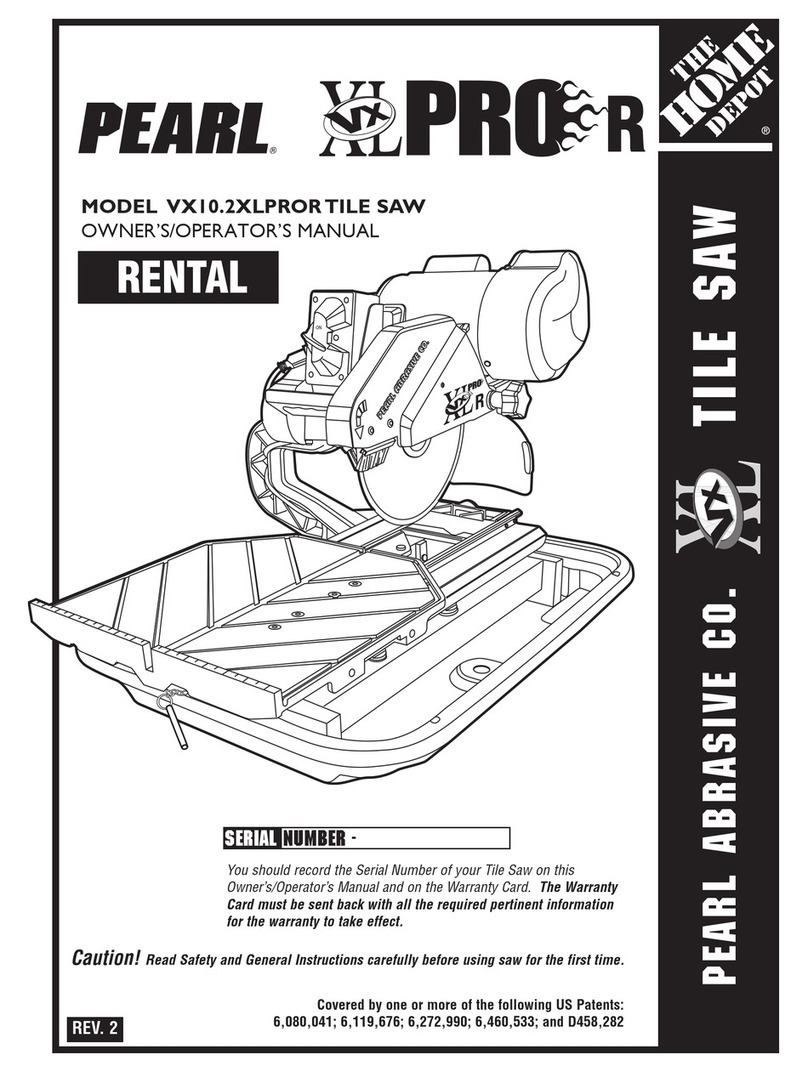
Pearl
Pearl VX10.2XLPROR Owner's manual

Pearl
Pearl VX141MSD Owner's manual
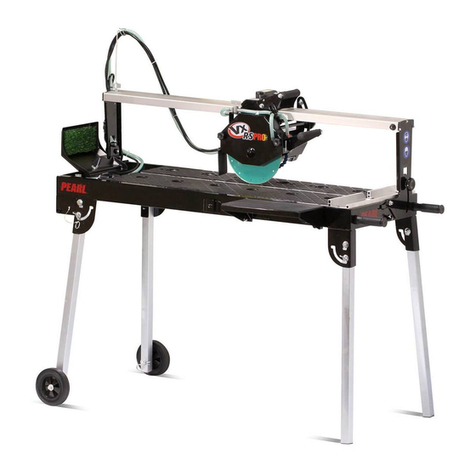
Pearl
Pearl VX RSPRO VX1048RSPRO Owner's manual
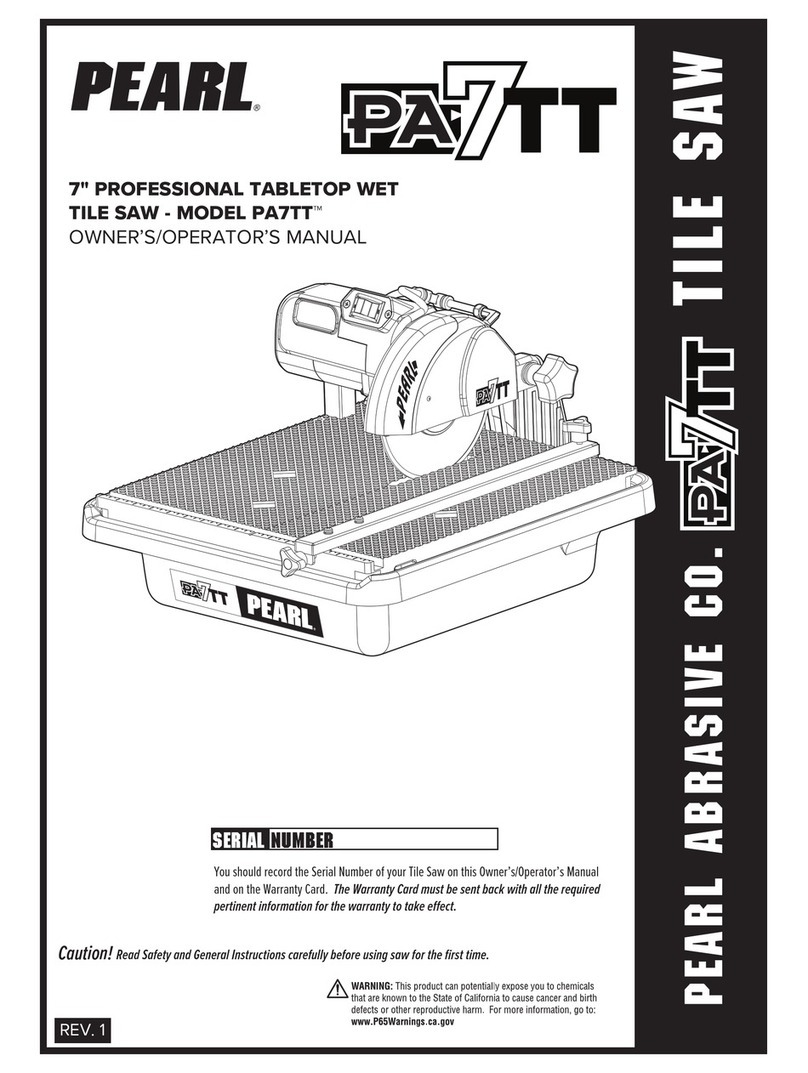
Pearl
Pearl PA7TT Owner's manual
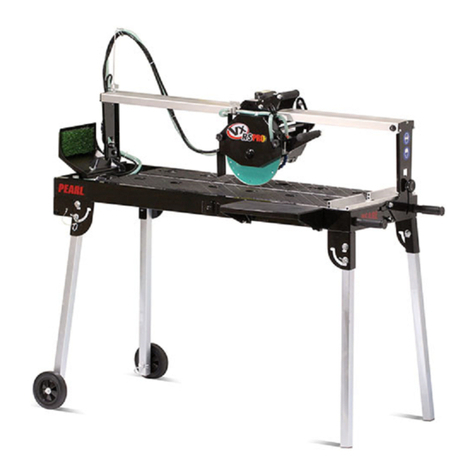
Pearl
Pearl VX10RSPRO Owner's manual
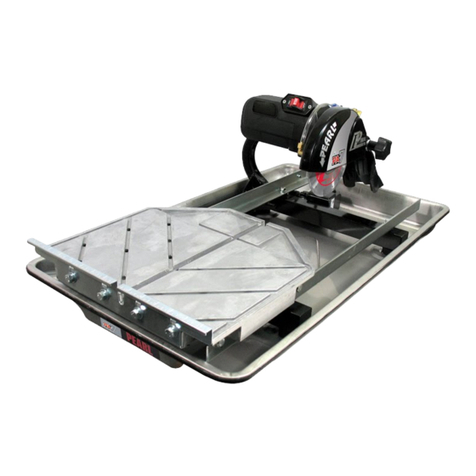
Pearl
Pearl PA-7 Owner's manual
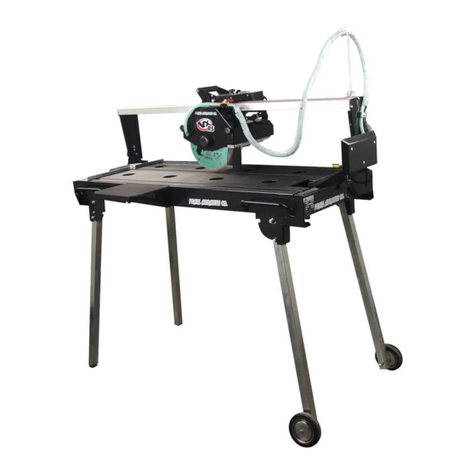
Pearl
Pearl VX RSPRO R Owner's manual
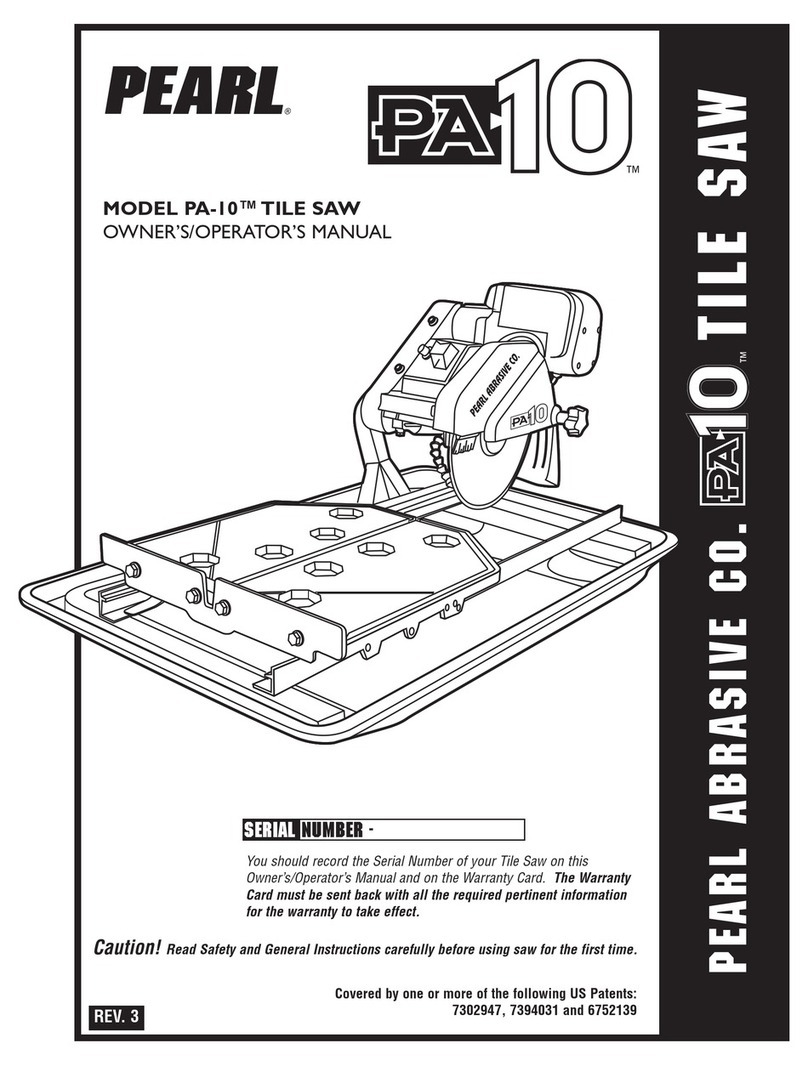
Pearl
Pearl PA-10 User manual
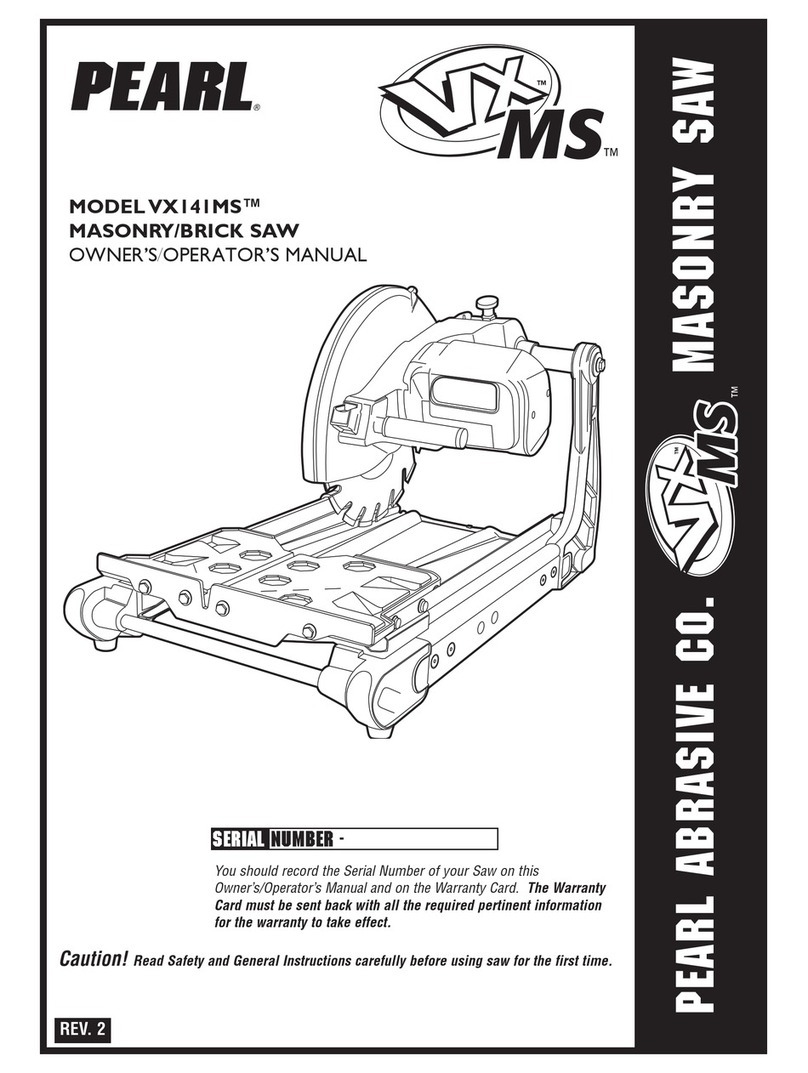
Pearl
Pearl VX141MS User manual
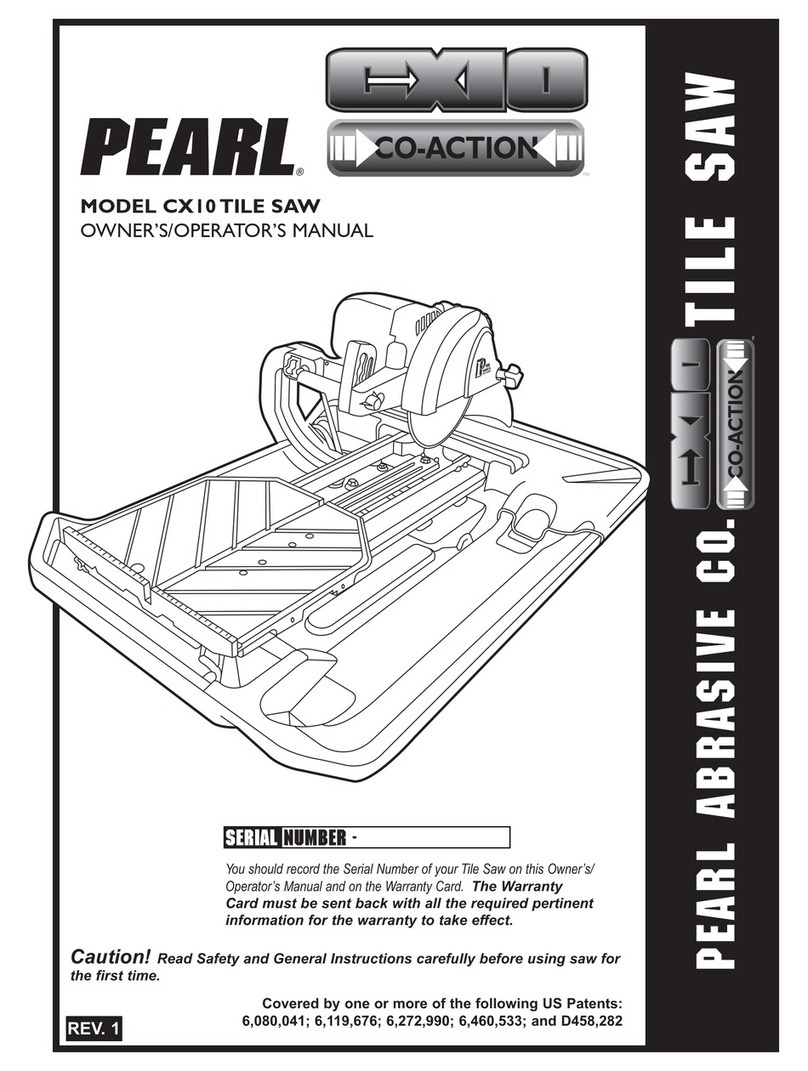
Pearl
Pearl CX10 Owner's manual
Popular Saw manuals by other brands
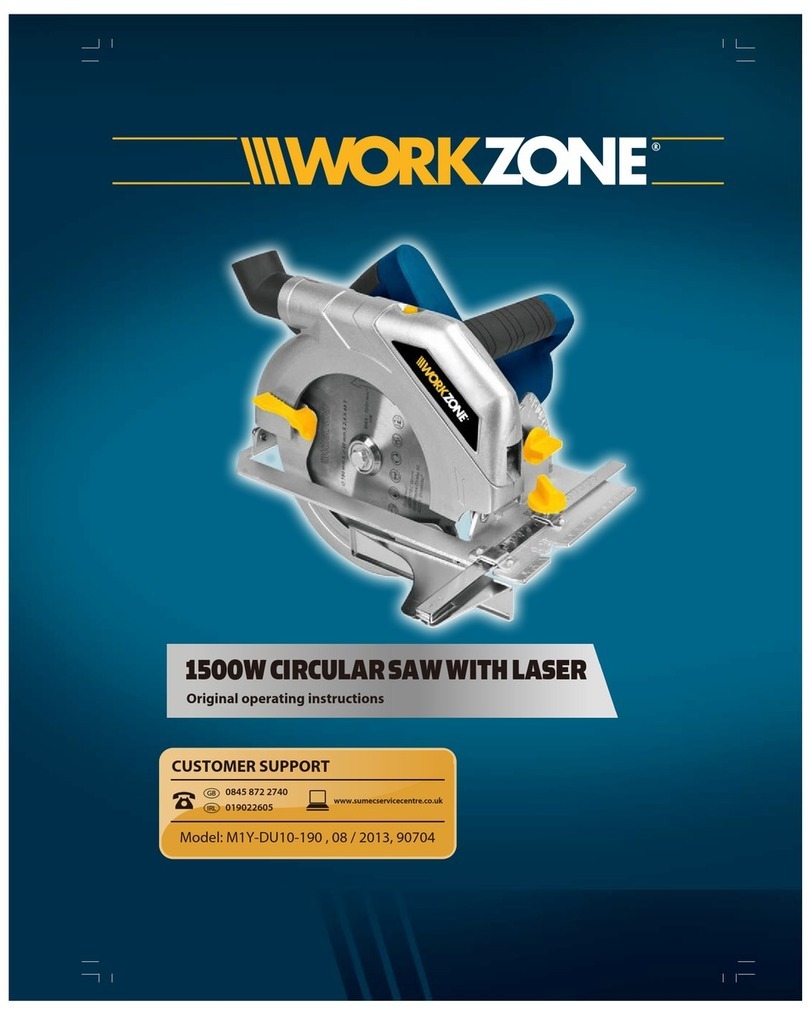
Workzone
Workzone M1Y-DU10-190 Original operating instructions

DeWalt
DeWalt DW708 user manual
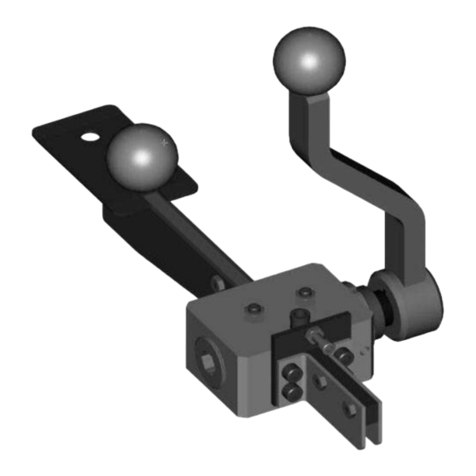
HANCHETT MANUFACTURING
HANCHETT MANUFACTURING 9900 operating instructions
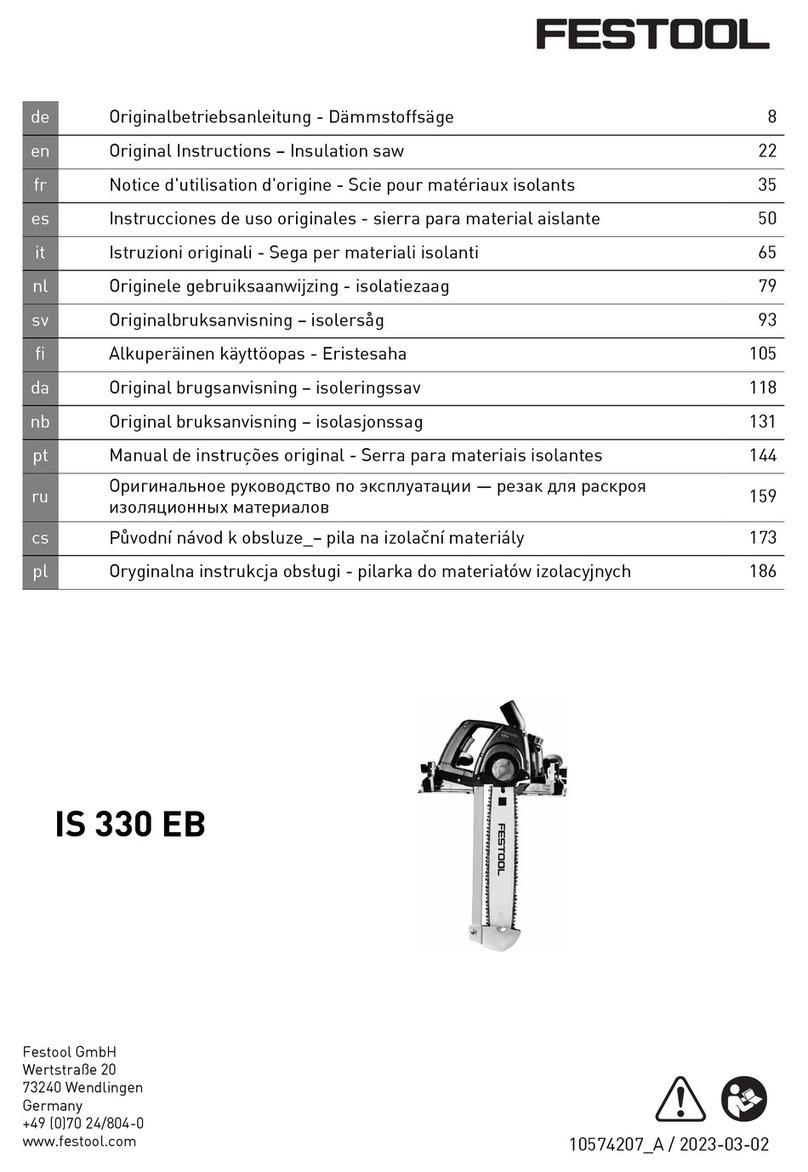
Festool
Festool IS 330 EB Original instructions
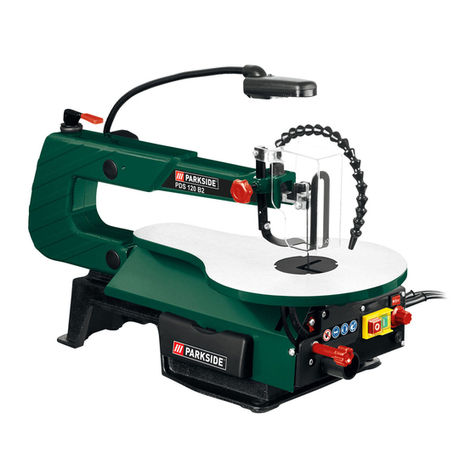
Parkside
Parkside PDS 120 B2 Operating and safety instructions
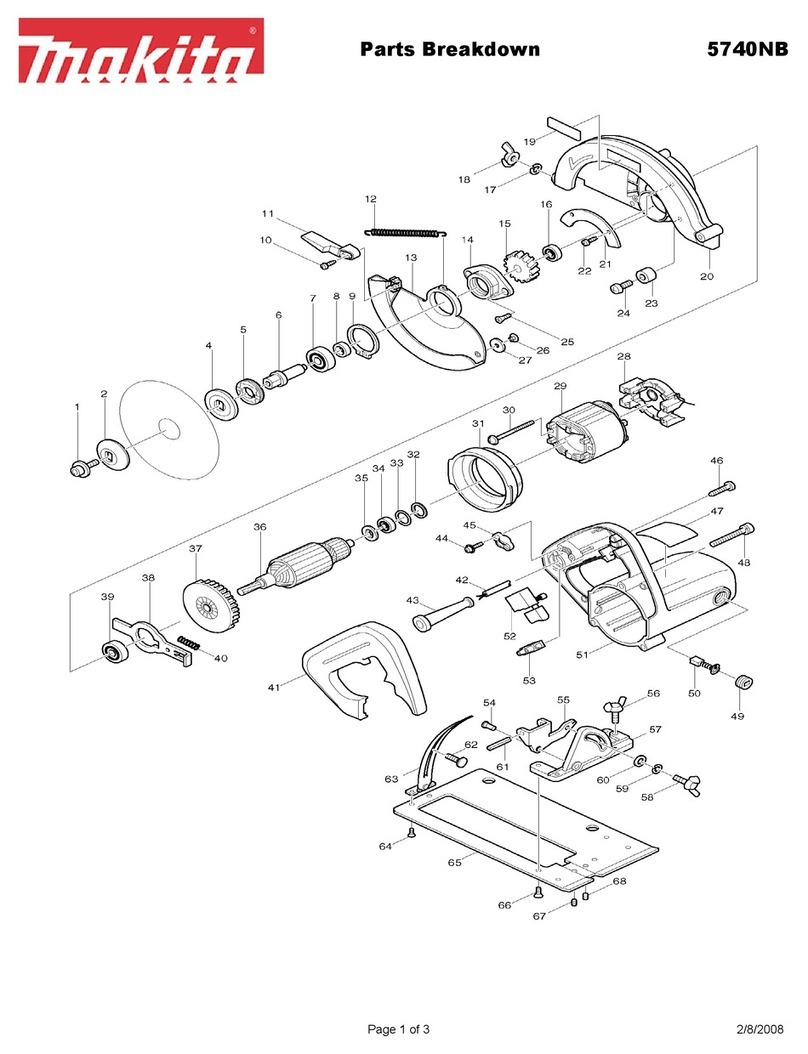
Makita
Makita 5740NB Parts Breakdown
